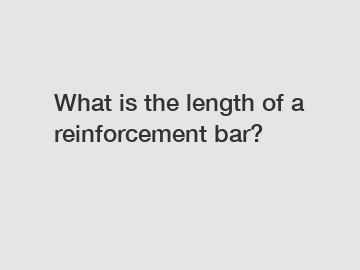What is the length of a reinforcement bar?
What is the Length of a Reinforcement Bar?
Reinforcement bars, commonly known as rebars, are essential components used in construction to provide strength and stability to structural elements. These steel bars are embedded within concrete to enhance its tensile strength and prevent cracks from forming. They are available in various diameters and lengths, catering to different construction requirements. In this article, we will explore the lengths of reinforcement bars and their significance in the construction industry.
Standard Lengths of Reinforcement Bars.

Rebars come in standard lengths that are easily available in the market. The length of a reinforcement bar typically ranges between 30 feet (9 meters) and 60 feet (18 meters). However, it is crucial to note that the actual length can vary based on regional standards, construction practices, and specific project requirements. .
The Importance of Length in Reinforcement Bars.
The length of a reinforcement bar plays a vital role in the construction process. It determines the span of the bar within a structure, affecting the overall strength and integrity of the building. In applications such as beams, columns, and floor slabs, the length of rebars needs to be carefully considered to ensure proper load distribution and structural stability. .
Cutting and Joining Reinforcement Bars.
In construction projects, it is often necessary to cut and join rebars to achieve the desired length. Reinforcement bar cutting and joining techniques are employed to adapt the bars according to the specific needs of a structure. Specialized tools like rebar cutters and threaders are used to make precise cuts and create threaded ends for easy joining. Welding, mechanical couplers, and overlapping are common methods used to connect reinforcement bars and maintain their continuity.
Factors Influencing the Length of Reinforcement Bars.
Several factors influence the determination of reinforcement bar lengths in construction projects. These factors include the building design, structural requirements, architectural considerations, and local building codes and regulations. The span of beams, columns, and other load-bearing elements, as well as the spacing between bars, play a role in deciding the appropriate length of rebars. Engineering calculations and structural analysis are often carried out to ensure the correct sizing and placement of reinforcement bars.
Specialized Reinforcement Bar Lengths.
While standard lengths are readily available, there are instances where specialized lengths of rebars are required. These scenarios include curved sections of a structure, complex architectural designs, or non-standard construction practices. In such cases, fabricators may provide customized lengths tailored to the specific project requirements. However, it is important to note that customized lengths often come at an additional cost and may require longer lead times for procurement.
Conclusion.
Reinforcement bars are indispensable in the construction industry, providing strength and durability to concrete structures. The length of a reinforcement bar is a critical factor in ensuring the stability and load-bearing capacity of a building. By considering factors such as building design, structural requirements, and local codes, engineers and architects can determine the appropriate lengths for rebars in their projects. Specialized lengths may be required in certain cases, but they should be carefully assessed for cost-effectiveness and feasibility. For further information on reinforcement bars and their lengths, please do not hesitate to contact us.
Are you interested in learning more about 700mpa, thread bar information, 12m threaded rod? Contact us today to secure an expert consultation!
170
0
0


Comments
All Comments (0)